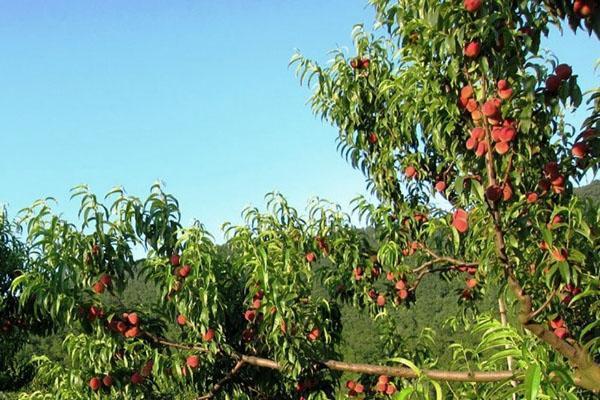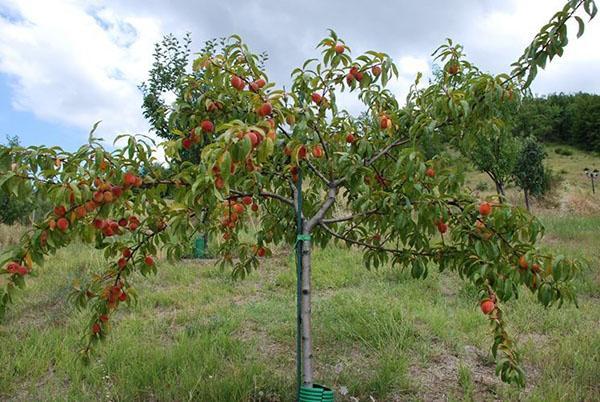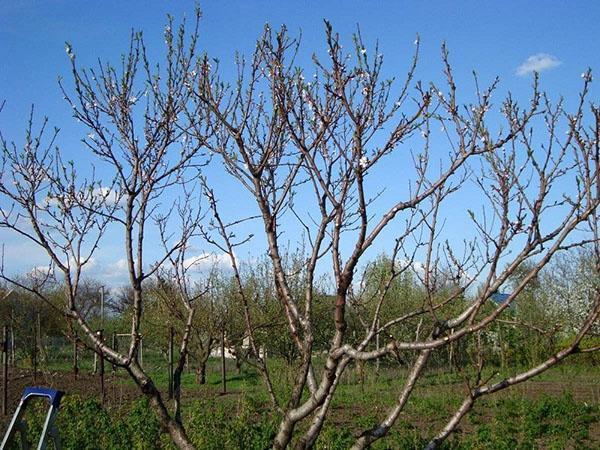How to grow a peach tree and get a bountiful harvest
 It has always been considered that the peach tree, its spring flowering and bountiful harvest is the privilege of the southernmost regions of the country. Since the middle of the last century, breeders and hobbyists have been promoting the crop to the middle lane. Peach can press apricots in country gardens, because it is more resistant to return frost, and the seedling from the seed inherits maternal qualities. Fifty fans of the Moscow region have been cultivating peach in bush form for more than 10 years.
It has always been considered that the peach tree, its spring flowering and bountiful harvest is the privilege of the southernmost regions of the country. Since the middle of the last century, breeders and hobbyists have been promoting the crop to the middle lane. Peach can press apricots in country gardens, because it is more resistant to return frost, and the seedling from the seed inherits maternal qualities. Fifty fans of the Moscow region have been cultivating peach in bush form for more than 10 years.
Description of the peach tree

The peach tree is a cross-pollinated species. Several nearby growing varieties will increase the fruiting of each, especially if you create a conveyor of fruits from July to September, collecting specimens of different ripening periods. Keeping peaches are low.
Peach trees cannot be called frost-resistant. They lose some of the roots during winter frosts -250if they last more than three days. The roots will withstand a severe frost of 30-35 degrees for a day. A short dormant period awakens the tree with winter growths occurring in winter.
The delicate peach is difficult to winter. The crown does not withstand frost without shelter -200, while fruit buds and last year's growth die. It is comforting that the peach tree has a great self-healing ability and in a year the frozen tree will bloom again.
Peach farming technology for every climate zone
 It is customary to grow a peach tree in climatic zones with a mild climate. At the same time, a cup-shaped crown, pierced by the sun's rays, is formed, located at a distance of at least 3 meters.
It is customary to grow a peach tree in climatic zones with a mild climate. At the same time, a cup-shaped crown, pierced by the sun's rays, is formed, located at a distance of at least 3 meters.
For areas with cold winters, a bush form and thickened plantings are more suitable. Here, fruit links are formed from the lower shoots. Low-lying branches are easy to cover in winter, ensuring the safety of the fruit buds.
Only seedlings of zoned and recommended peach varieties should be purchased. A good result is obtained by gardeners by growing a tree from a local variety of peach pits.
 Peach care is year-round, and includes techniques to create conditions for long-term annual fruiting. Therefore, peach agrotechnology in the Caucasus and in the Moscow region includes one operation, but they are performed using different technologies:
Peach care is year-round, and includes techniques to create conditions for long-term annual fruiting. Therefore, peach agrotechnology in the Caucasus and in the Moscow region includes one operation, but they are performed using different technologies:
- planting dates and varieties;
- the formation of a young and fruitful tree;
- watering and feeding;
- protection against pests and diseases;
- preparation for wintering and spring awakening of the tree.
Each of these activities is based on practical techniques to help the demanding tree survive in hostile conditions.
How to grow a fruiting peach tree in the suburbs
 The studies carried out by the scientists of the Botanical Garden, who studied the experience of amateurs of gardeners in the Moscow region on growing peaches, led to some conclusions:
The studies carried out by the scientists of the Botanical Garden, who studied the experience of amateurs of gardeners in the Moscow region on growing peaches, led to some conclusions:
- Seedlings grown from seeds of local varieties retain their maternal qualities when taken from a native peach. Seedlings from rootstocks are sterile.
- Own-rooted peaches are highly resistant to local conditions.
- It is proposed to shape the fruit tree so as to give it a bushy shape, leaving predominantly young growth.
- Trees should be planted so that they can be sheltered in the middle of winter. Create a screen from the north wind even in summer.
- Use saplings grafted onto almonds and cherry plums. Apricot Peach Jardel is an unsuccessful stock.
Gardeners and fans of the Moscow region are advised to purchase seedlings of zoned varieties from local nurseries. So far, there are only 29 varieties, but breeding work continues.
How to care for a peach tree? An example of proper agricultural technology for the middle lane is the garden of the amateur Kostetsky. The harvest from each of 20 peaches in 2011 amounted to 30 kg per tree. He got such results, adapting to the needs of the southerners for 20 years.
 Recommendations for those interested in growing peaches in the Moscow region:
Recommendations for those interested in growing peaches in the Moscow region:
- Planting several varieties of seedlings with a distance between holes 3x4 meters.
- Spring cutting of dry, weak, non-fruiting branches. After flowering, thinning is required, removal of excess ovary, then the fruits reach 150-200 g of weight.
- Protection - 4 times in the spring, spraying with 1% copper sulfate against curly leaves, perforated spot.
Fertilizes plants all year round. After a year, 3 kg / sq. m of the area of the humus plot in the mixture superphosphate and potassium salt over the entire garden area in autumn. In early spring, fertilize with liquid organic matter annually. In winter, more than half a bucket of wood ash is poured into each hole. In the spring, when the buds swell, 300 g of complex fertilizer is introduced into the trunk circle, filled with 5-6 buckets of water. After flowering, liquid 10% organic matter is introduced into the trunk circle in the amount of 3-4 buckets. In August, feeding is repeated with the addition of half a glass of superphosphate to the bucket.
In the fall, when the foliage has fallen off, each tree receives 10 more buckets of water. Then the earth is mulched with humus. There is always space near the trunk to prevent diaper rash.
Getting a peach seedling from the seed
 If you take a seed from a native rooted peach variety, it will give the seedling the resistance to climatic conditions, the size and taste of the mother fruit. How to grow a peach from a stone? Can be grown at home, in a pot. To do this, hold the bone in water for 4 days, then remove it, split the bone, and plant the nucleolus in a pot.
If you take a seed from a native rooted peach variety, it will give the seedling the resistance to climatic conditions, the size and taste of the mother fruit. How to grow a peach from a stone? Can be grown at home, in a pot. To do this, hold the bone in water for 4 days, then remove it, split the bone, and plant the nucleolus in a pot.
For spring planting of peaches, it is necessary to carry out artificial stratification in winter. In a cool place, the bone is stored throughout the winter in wet sand. In the spring, the bone will burst, a sprout will appear, it needs to be arranged in a tub.
In the fall, you can spread the seeds into well-prepared soil at a distance of 10 cm. In the spring they will sprout, by the fall they will reach a height of 1.5 m, and will give side branches. Then they are seated in prepared planting pits.
In autumn, young plants are planted without cutting off the upper branches, but the roots are slightly shortened. In the spring, on the contrary, the tops are pinched, starting the formation of the tree.
Spring is the most crucial period in peach care
 Nature is awakening. It was at this time that the gardener began to suffer to protect the peach from pests and diseases, and pruning to shape the future harvest.
Nature is awakening. It was at this time that the gardener began to suffer to protect the peach from pests and diseases, and pruning to shape the future harvest.
Caring for a peach in spring is the timely release of branches and roots from the protective cover so as not to create diaper rash in the trunk. At the same time, protective measures should be taken, feeding should be carried out in accordance with the schedule. As soon as the flower buds begin to swell, within 3 weeks, the grower begins to form the crown. The event is responsible, requiring practical skills and well-sharpened tools. How to properly prune peaches in spring, watch the video for beginners:
The main goals of spring pruning are:
- rid the tree of fattening branches;
- free access to the sun's rays for fruiting shoots;
- remove old branches on which there are already few fruitful shoots.
 It should be remembered that pruning is an operation during which you can weaken the tree. She should be as gentle as possible. It is impossible to close the wet cut with garden pitch immediately after pruning. You can apply a protective layer after 3-4 days, so as not to get gum leakage.
It should be remembered that pruning is an operation during which you can weaken the tree. She should be as gentle as possible. It is impossible to close the wet cut with garden pitch immediately after pruning. You can apply a protective layer after 3-4 days, so as not to get gum leakage.
Only a well-groomed, strong tree can become a decoration of the garden and bear delicious aromatic fruits.